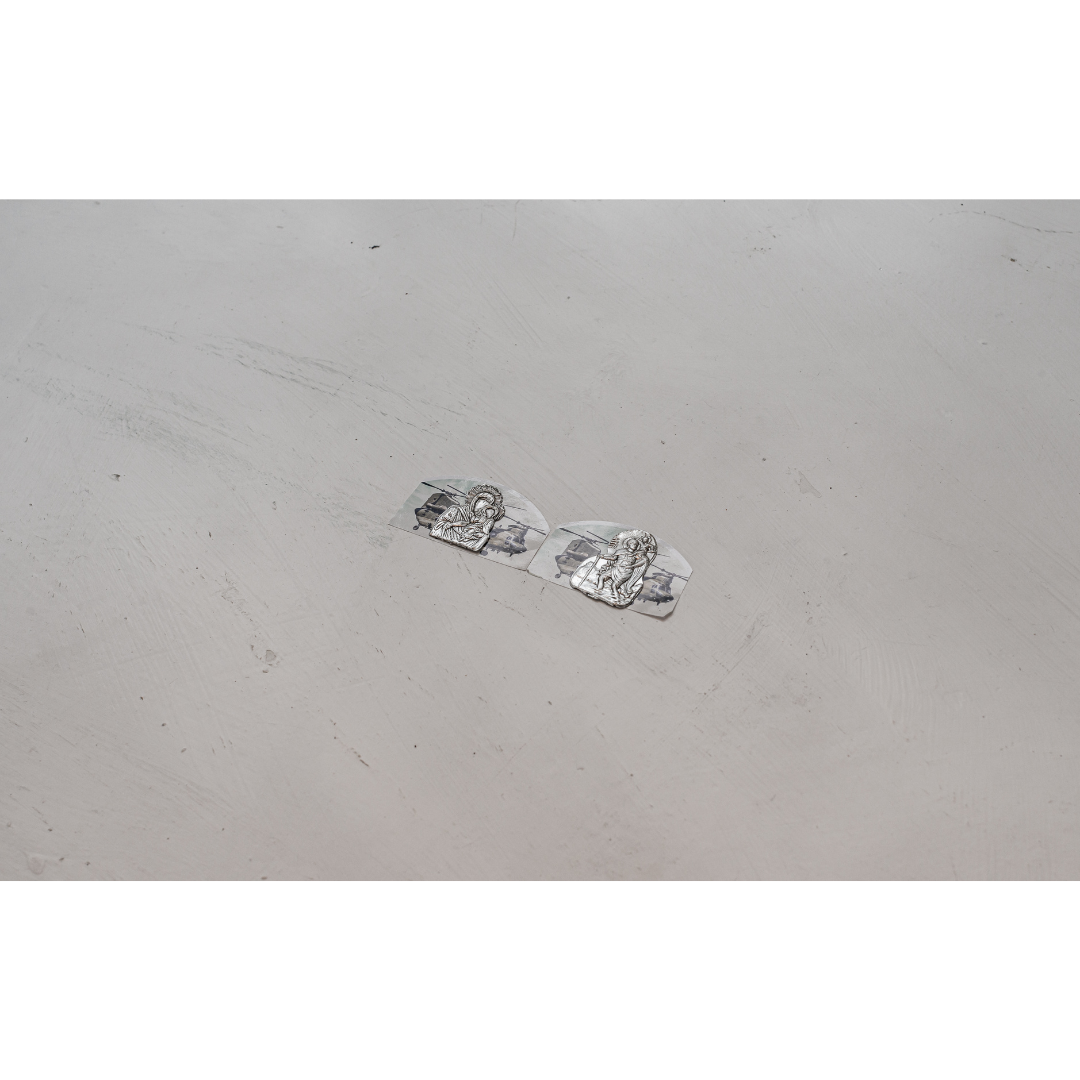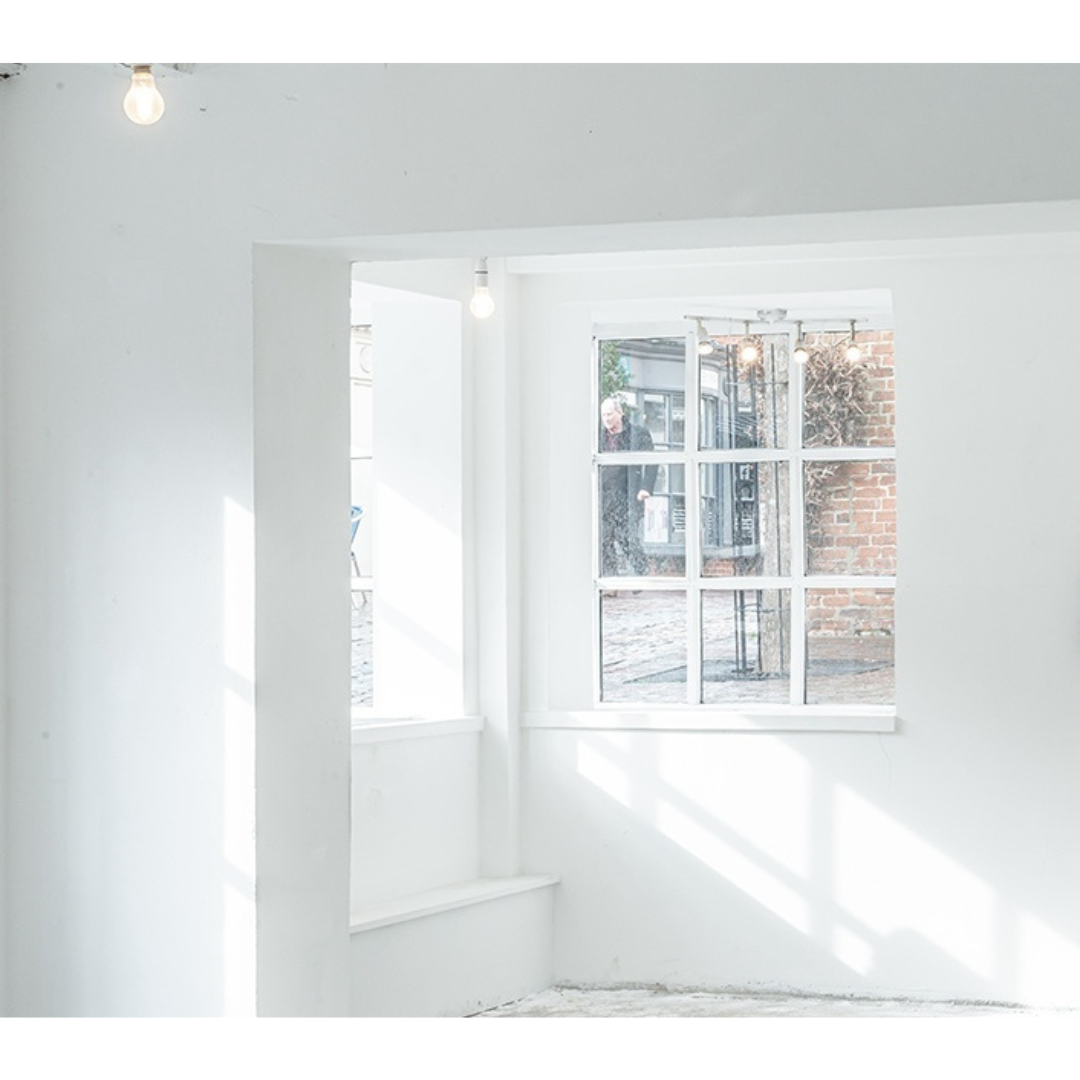





Close Considerations
Military insignia and narrative counterpoint: This work incorporates two pre-existing miniature silver ornaments carried by soldiers, either in pockets or as pendants. These ornaments are juxtaposed with artist-created stickers depicting military helicopters, strategically positioned beneath the ornaments. This intentional placement creates a narrative counterpoint between the pre-existing religious symbolism (ornaments) and the newly introduced representation of military power (stickers).
Subdued metallic lustre: The ornaments exhibit a neutral and subdued silver sheen which aligns with the overall aesthetic of other works within the exhibition.
Dimensional discrepancy and symbolic intersection: This work employs a miniature format, diverging significantly from the average size of other works within the exhibition. Papandreopoulos positions the helicopter stickers beneath the reflective silver ornaments, reducing their initial visual salience. This points to the often-overlookedness of the intersection between religion and military power.
Subverted halo: The work is placed in a niche by a window. This placement allows for natural light to reflect on the ornaments, creating an effect that mimics a religious halo motif commonly observed in monastic settings. However, the light in this context does not illuminate a 'divine power' but rather serves to highlight the opposing force of military power embodied by the helicopter imagery.



Process
Accidental conceptual link: The concept for this work emerged through a serendipitous process within the studio environment. The spatial co-location of disparate visual stimuli – imagery of military helicopters and religious saint ornaments – triggered an unforeseen conceptual connection. It is important to note that these objects were not initially intended for a specific project.
Object analysis and procurement: The helicopter stickers were derived from Papandreopoulos’s research archive of military equipment, and the ornaments were acquired from stores commonly used by the Greek public for religious paraphernalia.
Irreverent juxtaposition: Papandreopoulos used a multimodal approach, combining pre-existing and newly created elements. The stickers were specifically designed and produced for this work. Conversely, the saint ornaments were acquired in a "ready-made" state, emphasising the irreverence of the juxtaposition of the two material categories.




References
Religious background and cognitive dissonance: Theo Papandreopoulos's work stems from his upbringing within a religious family who enforced certain alienating values associated with Orthodox Christianity. His experience within the military, like witnessing the monthly ritual blessing of weapons and repression of individuality, presented a significant cognitive dissonance due the inherent contradiction between the act of sanctifying instruments of destruction and the core tenets of the faith.
Authoritarian aesthetic discourse: Papandreopoulos’s monumental, banal objects reference the historical practice of using scale to reinforce power. He has mentioned the colossal pharaoh statues of ancient Egypt, where size directly correlated with a ruler's authority, and more recently, collectivist regimes like Nazi Germany and the Soviet Union employed oversized sculptures of idealised bodies, to overwhelm viewers and instil awe, reinforcing the state's supposed invincibility, right to control and direct citizens’ aspirations.
Tom of Finland’s erotic deviance: Papandreopoulos identifies an aesthetic parallel between the exaggerated masculinity depicted by the collectivist regimes of Nazi Germany and the Soviet Union and Tom of Finland's work which directly deals with their sexual appeal, which the former was fundamentally against. Tom of Finland's work utilises extreme versions of masculinity in uniforms, blurring the line between art and pornography. This reference presents masculinity as a potentially transgressive concept as an individualised erotic deviance in its own right.
Military conscription: A lot of Papandreopoulos’s art practice draws influence from his experience in the Greek military. This experience sharpened his observations of symbols used to establish and reinforce hierarchies and power structures. These symbols can be observed in the imposition of stoic aesthetics, adherence to austerity, enforced uniformity, and emphasis on order. Notably, these elements extend beyond the military context, influencing civilian life through state and corporate control mechanisms.
Samuel Beckett’s examination of disoriented masculinity: The exhibition title originated from Samuel Beckett's short story titled "Echo's Bones," which explores themes of violence and manhood. The regimented life depicted in Papandreopoulos's "Echo's Bones" exhibition, mirroring Beckett's characters in Theatre of the Absurd plays, reflects a potential loss of identity. This suggests a parallel between the disorientation experienced by soldiers in a highly structured environment and the struggles faced by contemporary men grappling with traditional notions of masculinity.
Francis Bacon’s examination of power: By analysing the connections between Samuel Beckett's penultimate work and Francis Bacon's late paintings, a link can be established with Papandreopoulos's practice. All three artists explore the nature of masculinity, portraying it as a constantly shifting concept characterised by doubt and complexity. Their work suggests that male identity is not fixed but rather allows for fluidity and the potential for transformation.


